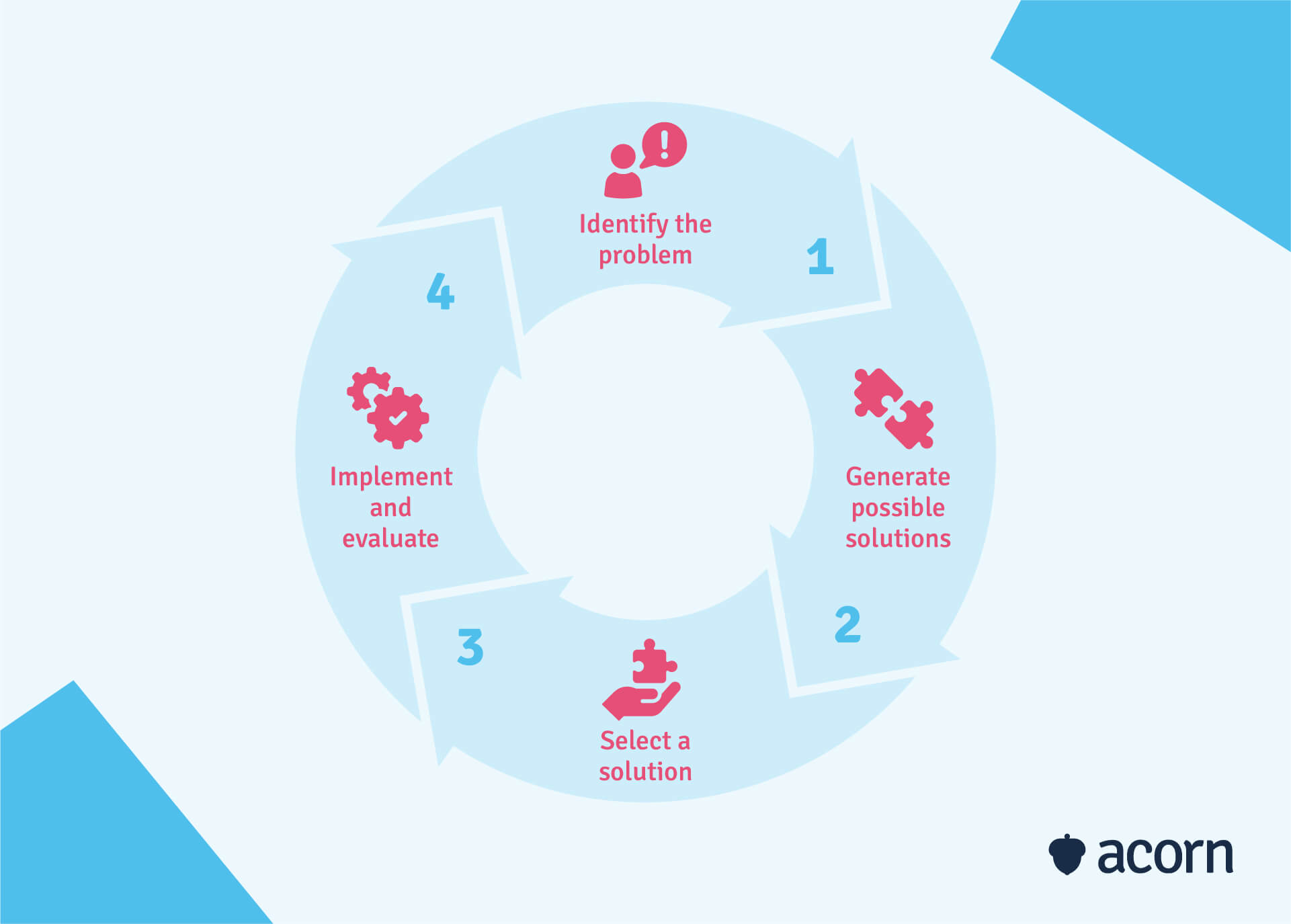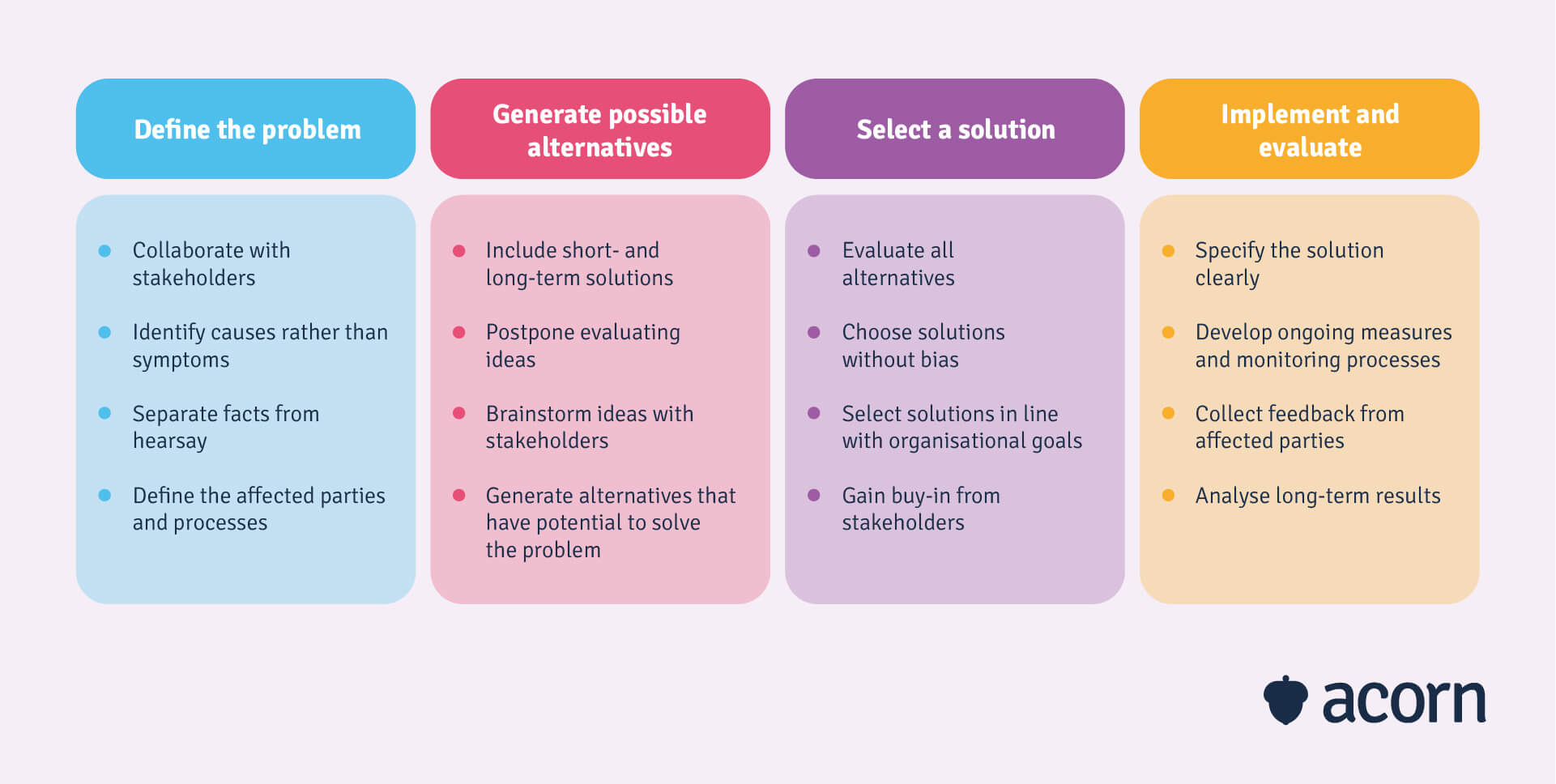4 Effective Problem-Solving Strategies and Skills for the Workplace
Reading Time:

Lead the pack with the latest in strategic L&D every month— straight to your inbox.
SubscribeLeaders need to have and encourage problem-solving skills in their teams.
Regardless of how many tools and processes are in place, there will come a time when a leader must deal with unexpected problems in the workplace. It’s important that a leader focuses on building problem-solving skills within their team to enact change in the organisation. Without problem solving, businesses operate inefficiently and are unable to match organisational strategy.
In this article we’ll discuss the problem-solving process and the problem-solving skills leaders require for success.
What is problem-solving?
Problem-solving is the process of finding solutions to meet a goal by overcoming obstacles. It involves identifying problems and taking time developing and implementing solutions to them. In the workplace, this means dealing with issues such as project deadlines, changing variables and other business-related topics that can affect the performance and health of your organisation.
Importance of problem-solving skills in leadership
In leadership, problem-solving is about reducing risk and pushing your team to meet organisational outcomes. When things go wrong, it’s up to leaders to fix them—and be strategic about it.
This means ensuring the solution leads to long-lasting change in the workplace. Adjusting processes so that you won’t fall into the same trap next time, facilitating the development of problem-solving skills in team members, or setting up a clear foundational strategy to use as a basis for problem-solving activities in the future. It’s all about minimising the impact a future problem will have on the business, thereby making the problem-solving process more efficient.
In terms of meeting organisational outcomes, you want to meet your business goals, not meander from the path. It’s up to leaders to make sure that whatever solution is chosen and implemented, it will set your business on a trajectory towards organisational values and priorities.
This is why we’ve created the first performance learning management system (PLMS) here at Acorn. It’s a dynamic AI-powered platform for that synchronises L&D experience with business performance, by guiding learners step-by-step to master the role-specific capabilities that accelerate organisational performance.
The problem-solving process

Sometimes, you come across a tough problem to solve, and finding possible solutions for it can feel overwhelming, especially when there’s a lot at stake. Enter: The problem-solving process.
In simple terms, the problem-solving process is broken into four separate stages, which we’ll get into in more detail below.
- Identify the problem
- Generate possible solutions
- Select a solution
- Implement and evaluate.
Identify the problem
When problems arise they can take many forms, which is why you need to be sure that what you’re identifying is the cause of the problem and not just symptoms. Ask questions to find the root cause.
- Who is involved with or most affected by the problem?
- What is happening?
- When did it happen? Is it urgent?
- Where did it happen, and does it affect anything else?
- Why is the issue impacting workflows and team members?
- How is it impacting workflows and team members?
Asking these questions will probably reveal a lot of smaller issues which will help you define the real problem. Plus, having an overview of all the smaller issues affecting the course of productivity in your organisation paints a clear picture of what problems need to be addressed.
Generate alternatives
Brainstorm multiple ideas. If you immediately lock in on the first solution you come up with you might be depriving your organisation of a better fix. The best thing to do here is not to analyse the best course of action as you go—rather, wait until you have a selection of alternative solutions first before you weigh the merits of each one.
It’s also important to remember who you identified in the first step as being involved or affected by the problem. These people are stakeholders in the process and should be consulted to discuss potential courses of action, thanks to their unique perspectives.
The solutions you brainstorm should be in line with your business strategy, regardless of whether those solutions are long- or short-term.
Select an alternative
To determine which solution is best, you should consider the following questions:
- Will this solution fix the problem better than other alternatives?
- Will all your stakeholders agree with using this alternative?
- Does your organisation have the capacity to implement it?
- Is implementation of the solution likely to happen?
You need to make sure you examine all potential alternatives without bias to find the most effective solution for your specific problem. Rushing to select a solution without proper evaluation could result in more problems arising.
Implement solutions and follow up
Work with the people most affected by the problem before bringing in others to implement your solution. This is an important step towards gaining buy-in for the implementation process, ensuring a better and more efficient roll-out.
After that, you need to evaluate and gather feedback. Communication should be open during implementation so you can course-correct any issues that arise during the process. Working on improving your solution as you go is effective problem solving at its best. And evaluating the efficacy of your solutions is a good habit for maintaining a healthy workplace.
The 4 most effective ways leaders can solve problems
By default, great leaders should be great problem solvers. They have good problem-solving skills with the right tools and focus to guide their teams through problems to specific solutions.
There are four effective problem-solving techniques leaders use to solve problems:
- Transparent communication
- Maintaining open-mindedness
- Refrain from the blame-game
- Connecting the dots.

Maintain transparent communication
Problem solving works best when people feel comfortable sharing their opinions and feedback. Fact-finding is essential to understanding complex problems and solving them. When you don’t have effective and transparent communication across your organisation you develop silos, and silos breed more issues that need fixing.
Transparent communication isn’t just about being able to share ideas with direct managers and vice versa. It’s about breaking down the boundaries within an organisation that create silos, allowing the flow of information. This way, employees will be able to roam freely and share creative thinking with a wider range of people across the business. Without open channels of communication, your siloed teams will become inefficient and less productive due to the lack of collaboration and shared knowledge and procedures.
Encourage open-mindedness
Of course, there will always be people who make it difficult to solve problems in the workplace. The best course of action is to search for the people within teams who lift others up and look beyond the most obvious details and facts on a daily basis. These are defining characteristics of problem solvers.
A person who has these characteristics is innovative and shows initiative when it comes to solving problems. They take risks and use problem solving failures as learning opportunities and resources for growth. You should nurture this open-mindedness and treat failure as a tool to learn from to become stronger at problem solving.
Stop the blame-game
A team needs to work together, and there’s no better way to teach that than to lead by example. Problem solving is ineffective when everyone is pointing fingers at each other for every little problem that comes to light.
Of course, you need to identify the cause of a problem if you want it to be solved, but that’s not the same as placing blame. Instead, work towards defining a solution to solve the problem (as well as ensuring history won’t repeat itself).
Connect the dots
Solving a problem is one thing, but creating widespread change that sticks is another. If you work to tackle problems without defining problem-solving strategies first, you’ll essentially be starting the process from scratch every time. But, with a foundational strategy in place you can streamline the journey to a solution.
Having a strategy gives you the benefits of knowing which tools and resources to bring in to find answers and when. This could be anything from which people to involve, budgeting and pre-existing knowledge and expertise. A problem-solving leader should be able to utilise strategies while also leading long-term change to prevent the same problem from recurring over and over again.
Key takeaways
Problem solving is an essential element of leadership, team work, workplace culture and overall business health, allowing the organisation to run smoothly and meet its desired business outcomes. By possessing and encouraging problem solving techniques in team members, they will work efficiently together to evaluate alternative solutions and define lasting change that benefits the whole organisation.